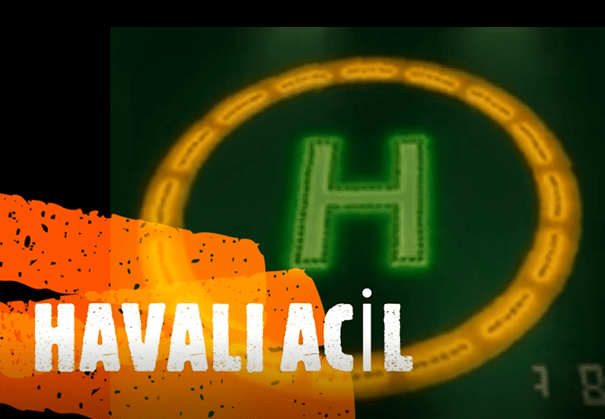

In newly built hospitals, patient transfers by air transport vehicles are given importance. This is observed both by being located close to air ambulances and by having helipads within the hospital. In hospitals with helipads, emergency services come to mind first in the transfer of the patient from the helipad to any unit of the hospital. In this article, we will talk about the transfer of patients from in-hospital heliports (heliports) and safe transport procedures in new emergency service models.
Natural disasters, wars, population increases, overcrowding in hospitals, inadequate non-emergency health services, pandemics, overcrowding in intensive care units and extraordinary situations have led to an increase in the need for emergency medicine all over the world. For this reason, the importance of meeting air ambulances in the field and in hospitals and in-hospital transfers has gradually increased.
It is known that the first patient transfer by air transport vehicles in the world was realized in 1870 for military purposes. In our country, air ambulance was used for military rescue for the first time. A patient with a lower extremity firearm injury, the distance of 3 days by land was reduced to 45 minutes. The increasing need for transfer by air transport vehicles has led to the issuance of circulars on this subject and its inclusion in the scope of new legislation. In the circular published on this subject; It is stated that all kinds of traumatic or non-traumatic emergency patients, critical patients, transportation of critical patients to another hospital, transportation of newborns in incubators, in mass emergencies, emergency transportation of drugs, samples, blood derivatives, transport operations for organ transplantation can be carried out.
In patients who will arrive by Air Ambulance; patients with multitrauma, acute coronary syndrome, events requiring fibrinolytic therapy, respiratory, inhalation or chemical burns, drowning, fractures that will progress to shock, open injuries in the chest, abdomen, head, neck or groin, patients with impaired consciousness, unstable vitals and respiration, low Glasgow coma and trauma score and limb loss should be known that we may encounter medical conditions for air ambulance transfer. In the literature, more than half of the referrals in studies examining referrals by air ambulance are trauma patients. In our country, the superiority of air ambulance with physician accompaniment in the transportation of trauma patients has been shown in the studies conducted.
The areas reserved for landing helicopters in health facilities are called heliports. The greatest danger in helicopter landings is the injury of healthcare workers as a result of the impact of the propeller blades and tail rotor. The fact that the propeller speed is lower and the blades are lower, especially when the wind speed is high, is the main factor in the danger. These dangers are exacerbated by increased noise levels. After patient delivery, while the engine is running, debris, dust, sand, snow and similar foreign materials rising from the ground are mobilized and may cause injuries to the crew and the patient. All personnel interacting with the helicopter ambulance should receive training on correct patient transportation techniques and landing zone safety. Personnel working in the heliport area should wear a bright heliport vest with high visibility to be seen by the landing helicopter. The heliport area should be free of personnel other than those on duty, and curious employees are not permitted access to the runway area. They should never approach the aircraft from behind as there is a risk of injury to the tail blades of most types of helicopter.
In new hospital models, Heliport health teams should be formed for patients arriving by air transport vehicles. This unit should consist of at least 6 people including 1 physician, 1 nurse, 1 security, 2 transportation, 1 technical personnel. The first evaluation of the patient transferred by helicopter in the hospital is anamnesis, rapid physical examination and ATLS plans the treatments required to ensure the continuation of vital functions until the transfer to the emergency room according to ACLS principles. This team should move quickly to the runway where the helicopter will land with the equipment on the check-list after the case notification is made, based on the route studied. In modern hospitals with more than one runway; according to the patient information from 112, the route is determined according to the procedure to be performed on the patient and the characteristics of the follow-up location (pediatric ICU-operating room-angiography-interventional radiology-emergency service). While the patient is received from the helicopter team; Security ensures environmental safety, Technical staff performs blocking procedures to ensure that the elevator and runway doors are used only for the use of the team and the patient. Health and transportation team; Proceeds to the Safe Control point determined in the runway area. They wait at the control point. With the landing of the helicopter and the stopping of the propellers, the 2nd delivery control point is reached. The hospital team ensures that the patient is taken on the stretcher with the helicopter crew. Patient information is received verbally from the flight crew. This notification should be short. The patient is taken to the safe control point. After procedures such as anamnesis, rapid physical examination, vitals are performed in the safe area, the first treatment is planned according to emergency guidelines
Patient information is transferred to the team that will take part in the long-term treatment at the hospital, the treatments performed and the information received from the helicopter team are transferred. All procedures are completed to identify and prepare the necessary materials and needs for the new mission.

Mehmet Necmeddin SUTAŞIR, MD
Clinic of Emergency Medicine, Sisli Hamidiye Etfal Training and Research Hospital, Istanbul, TURKEY

